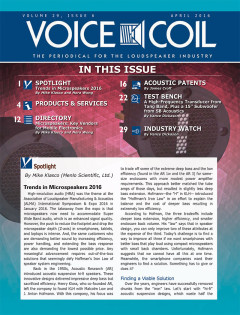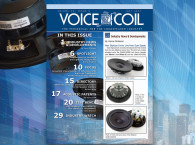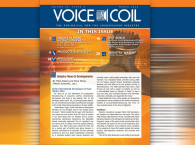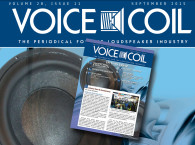 The April 2016 issue of Voice Coil is now ready for download. In Spotlight, Mike Klasco writes about “Trends in Microspeakers” and explains why new portable audio devices and smartphones are increasingly pushing the envelope to respond to better quality sound and high-resolution audio (HRA) sources. As Klasco writes, how “Hoffman’s Iron Law” - choose one of three tradeoffs of deeper bass extension, higher efficiency, and smaller enclosure back volume - is being continuously challenged in microspeaker design. “Today’s challenge is to find a way to improve all three if we want smartphones with better bass that play loud using compact microspeakers with small back chambers. Unfortunately, Hofmann suggests that we cannot have all this at one time. Meanwhile, the smartphone companies want their engineers to find a solution.”
The April 2016 issue of Voice Coil is now ready for download. In Spotlight, Mike Klasco writes about “Trends in Microspeakers” and explains why new portable audio devices and smartphones are increasingly pushing the envelope to respond to better quality sound and high-resolution audio (HRA) sources. As Klasco writes, how “Hoffman’s Iron Law” - choose one of three tradeoffs of deeper bass extension, higher efficiency, and smaller enclosure back volume - is being continuously challenged in microspeaker design. “Today’s challenge is to find a way to improve all three if we want smartphones with better bass that play loud using compact microspeakers with small back chambers. Unfortunately, Hofmann suggests that we cannot have all this at one time. Meanwhile, the smartphone companies want their engineers to find a solution.”This issue also features a complete Microspeaker Directory of Key Vendors for Mobile Electronics, compiled by Mike Klasco and Nora Wong (Menlo Scientific).
In the Acoustic Patents article, James Croft (Croft Acoustical) discusses a recent patent awarded to Daniel Beer (Martinroda) on behalf of Fraunhofer-Gesellschaft zur Foerderung der angewandten Forschung e.V. (Munich, Germany), describing an “Apparatus Using Missing Fundamental Frequencies to Improve Loudspeaker Sound Focusing.” The invention promises to successfully process an audio signal to focus an acoustic signal by an arrangement of a plurality of loudspeakers, comprising a frequency analyzer, a signal processor, and a signal output interface. The acoustic signal is based on the audio signal. The frequency analyzer is configured to determine a fundamental frequency in a frequency spectrum of the audio signal depending on a geometry parameter of the arrangement of the plurality of loudspeakers. The signal processor is configured to adapt an overtone of the fundamental frequency to obtain the processed audio signal and the signal output interface is configured to output the processed audio signal to the plurality of loudspeakers. As James Croft states, this approach can work quite well, even though there are well-known drawbacks that the patent intends to resolve.
A second patent on a “Compact Wideband Bass and Midrange Horn-Loaded Speaker System,” awarded in December 2015 to Anthony Allen Bisset (Oakland, CA) and Quang-Viet Nguyen (Aldie, VA) is also discussed and praised. The patent describes, a compact high-fidelity sound reproduction system achieving high efficiency, low distortion, wide bandwidth, and extended low-frequency reach and which can be used as a sub-bass woofer, bass woofer, mid-bass woofer, and mid-range speaker for residential or commercial large venue applications. The system includes a dynamic driver driven bass horn, a looped resonator duct (ring geometry), which can be folded, and an adjustable feedback duct allowing sound characteristics to be tailored.
Vance Dickason’s Test Bench features a high-frequency transducer, with a small diaphragm ribbon transducer that incorporates a matching transformer, from Tang Band Speaker, plus the SB42FHCL75-6 15” home audio subwoofer from SB Acoustics.
The Tang Band (TB) Speaker is the new RT-2202S, a closed-back ribbon tweeter device with a fairly small 30 mm × 10 mm ribbon diaphragm. Features include a thin aluminum foil diaphragm, an injection-molded faceplate, a metal chassis, Nd-Fe-B (neodymium) magnet, a matching transformer, and a pair of gold-plated solderable terminals. The RT-2202S is a rated 80 W maximum power handling (8 W nominal).
The SB Acoustics (Sinar Baja) SB42FHCL75-6 has an impressive feature set that includes a cast eight-spoke cast-aluminum frame (four double spokes) that have four 18 mm × 50 mm and four 18 mm × 10 mm vents below the spider mounting shelf for cooling across the top plate. The cone assembly utilizes a stiff 15” cone that is comprised of a hard paper honeycomb covered and woven glass-fiber sandwich, a 4.25” diameter hard polypropylene dust cap, a 12 mm × 25 mm nitrile butadiene rubber (NBR) high-excursion surround, and 6.5” diameter flat cloth spider, and silver tinsel lead wires that extend from about midpoint on the cone to both opposite mounted terminal sets.
Industry Watch highlights some of the activities scheduled for Prolight+Sound 2016 in Frankfurt, Germany, and the Association of Loudspeaker Manufacturing & Acoustics (ALMA)
International’s new education initiative - ALMA International Education Initiative (AEI) - designed to invite and engage all relevant stakeholders including students, educators, and manufacturers in discussions and activities that will promote and help to develop electro-acoustic specific education and opportunities for graduating students.
Note: Past issues of Voice Coil’s Test Bench can be found online here: http://audioxpress.com/category/vc-testbench.html
This latest issue of Voice Coil - as well as previous archived editions - is available to read online or download here: www.gotomyvcoil.com
To download the new issue, renew your subscription, or qualify for a free subscription to Voice Coil, just go here: http://audioxpress.com/page/Voice-Coil-Subscriber-Services.html






